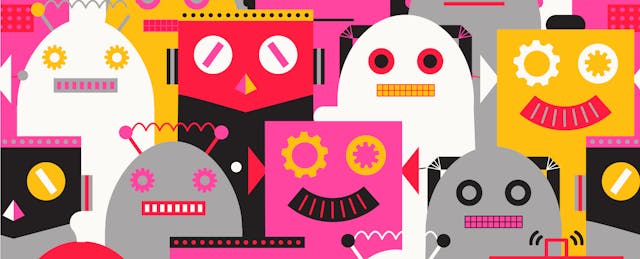For nearly 30 years, the global non-profit FIRST has been getting kids hooked on science and technology through hands-on robotics competitions for grades K-12—complete with cheering crowds, adrenaline rushes and teams snatching victory from the jaws of defeat. Students invent products, apply for patents, and fall in love with science.
FIRST president and former tech executive Don Bossi spoke with EdSurge about why robotics are the ideal gateway sport for budding innovators and how educators can get their students involved. He offered insight on why a diverse workforce is the best workforce, and how to go about creating it. And he shared inspiring stories about the life-changing power of tech know-how—especially for girls and homeless youth.
EdSurge: Here’s an elevator pitch we’ve heard—FIRST is bridging the STEM skills gap to create the only sport where every kid can go pro. Can you elaborate on that?
Don Bossi: We are very much about putting inspiration in front of education. Robotics competitions have the same thrills and excitement every other sport has. We give kids a challenging problem they want to accomplish, and along the way they realize, ‘gee, I actually have to use the math and science I’ve been learning to figure this out.’ Once the spark is lit, they start to take harder classes, and they are more interested in STEM as a career. The chances a high school athlete is going to become a pro athlete are one in a million. But we can say there are jobs out there for every kid who is developing skill sets from our programs.
There are a lot of coding programs that get kids excited, but it’s stickier when kids program something and see it move. I heard a young woman speak about her team going to its first event. They showed up with this pile of parts that couldn’t do anything. The minute her team’s robot moved, she and her teammates all screamed, ‘It MOOOOVED!!!' Everyone nearby started cheering because they know what an amazing moment that is.
What makes robotics competitions the ideal launching pad for creating future innovators, technology leaders, and creative problem-solvers?
It’s not that we think that robotics is the be all and end all. It’s a platform that has this ‘Oh, my gosh, I can’t believe we did that!’ type of impact on kids. And that’s what sets them down the path of thinking, ‘Maybe I have skills I never knew I had!’
We know that kids who participate in our programs, even for just one year, are two or three times more interested in science and technology than kids from their same classrooms who don’t. If we can reach the kids who are often the least encouraged to get interested in science, we can have an even bigger game-changing impact.
Can you share an example of how your work has impacted students’ lives?
There have been many, but one was Yohance Salimu, a homeless teen who joined the robotics team at Crenshaw High in South Central Los Angeles—in part because he thought it would be a safe place after school and that he might get fed. After joining the team, Yohance got to know a mentor from the nearby Aerospace Corporation, who offered him an internship. Yohance used the money from the internship to get his family out of the shelter and into an apartment. Most amazingly, he went on to become a cadet at the US Air Force Academy and is now a pilot and second lieutenant.
You focus on creating a culture of diversity and inclusion. Why is a diverse workforce the best workforce?
A diverse population is the customer set for almost every company. And I believe to build the products that serve that more diverse customer set, you need diverse input into the design and engineering process. There’s also a social imperative. If high-paying jobs and the ability to start companies are limited to a small subset of the population, that creates a tremendous opportunity gap and achievement gap.



Aside from STEM skills, what are the collateral benefits for kids who participate in your programs?
These kids learn skills like teamwork, collaboration, communication and leadership. They also learn innovation and entrepreneurship. Every year in our lower grade LEGO programs, we have a real-world theme. Not only do kids do a robotics challenge on that theme—it’s SPACE in 2019—they also do a project in which they go out in their community and identify a problem, invent a solution, and take it back to the people who inspired it for feedback. It’s very much like how a startup runs. Every year, at least 50 teams apply for patents based on their ideas; these are upper elementary and middle school kids!
I spent the first 30 years of my career in corporate management and venture capital. The one thing common in all of that? Hiring a great team usually led to great results. Great teams don't just have technical skills, they have soft skills—they can listen to customers, communicate, work together, hear other people’s great ideas and build upon them, or let people build upon their ideas. This is a gold mine, because what we are creating is exactly the type of workforce that every company wants to have.
Have any of those patents resulted in a marketed product?
The year our theme was food safety, a FIRST® LEGO® League team invented a refrigerated lunch box—later produced and distributed by Land’s End. Another one is the SMARTwheel, a steering wheel cover that prevents distracted driving by alerting drivers—and their parents—when they take their hands off the wheel, potentially to text.
How can educators get involved with FIRST?
Last season we had 530,000 students from 95 countries participate in our program. We did that with a staff of under 200. The magic link is our volunteers. Two thirds of our coaches and mentors are educators. Go to our website, firstinspires.org, and look at how we could help you start a program in your school. Better yet, start a whole progression of K-12 programs in your school district. If we get kids excited in elementary school, we want to make sure they have something to move on to in middle school and high school.
What I usually find is that if there’s one kid interested, there are others. This past season, Boeing, one of our corporate supporters, sent webcams out to these four under-resourced teams in remote areas; they found employees who were willing to mentor the kids remotely. The Boeing employees got so attached to the teams that they flew out to their competitions.
How would you like to see your organization grow?
We are the big player in the space, but the sad truth is we’re still only in 10% of K-12 schools in the United States. And those schools serve maybe 17.5% of the students in this country. So, we’re trying to figure out: how do we get to a place where every kid in every school has access to our program?



